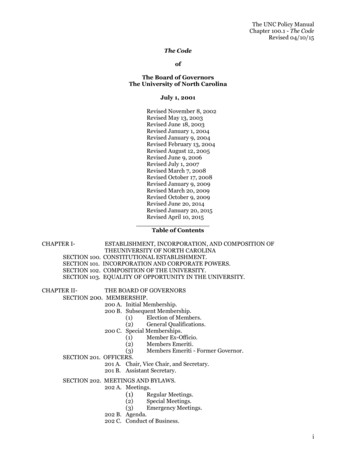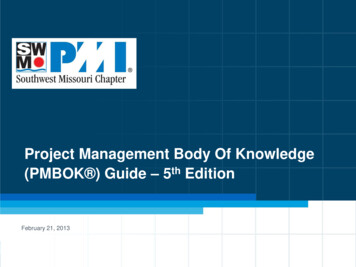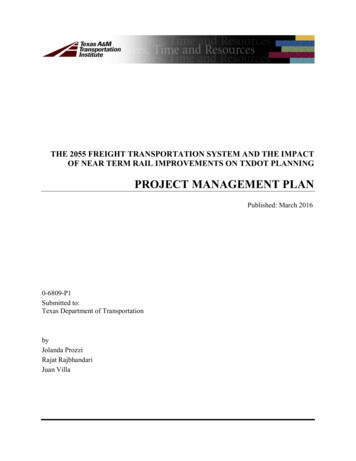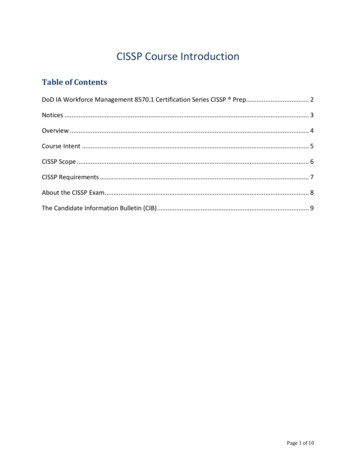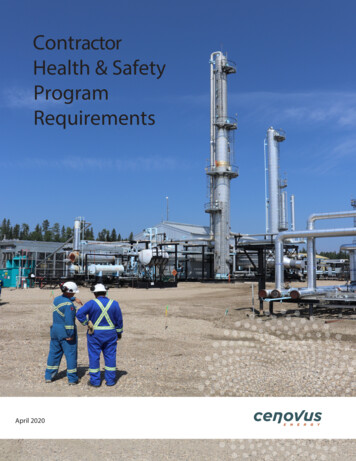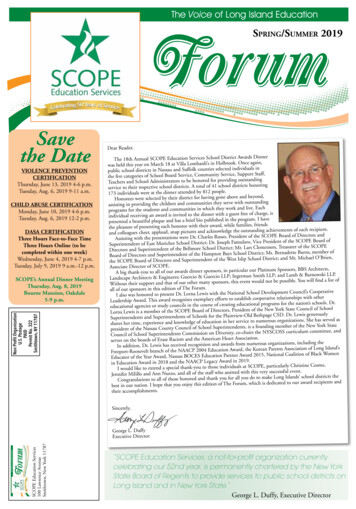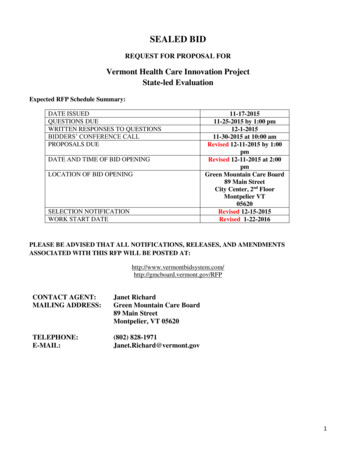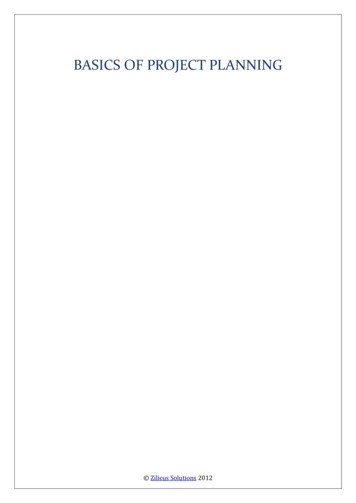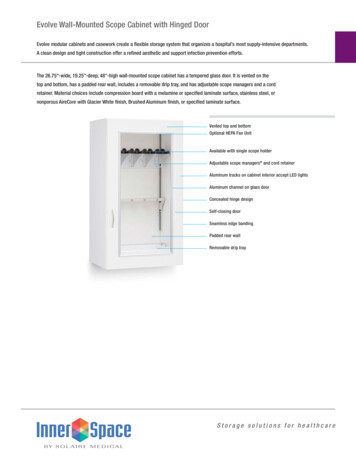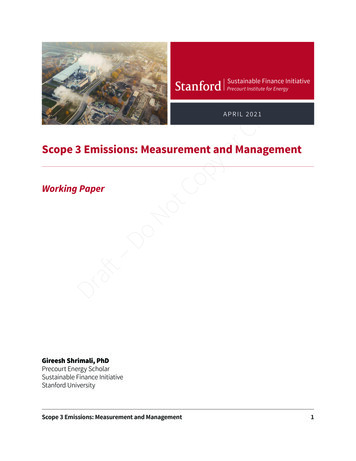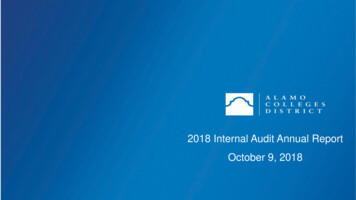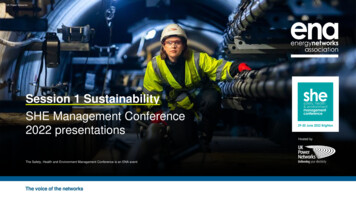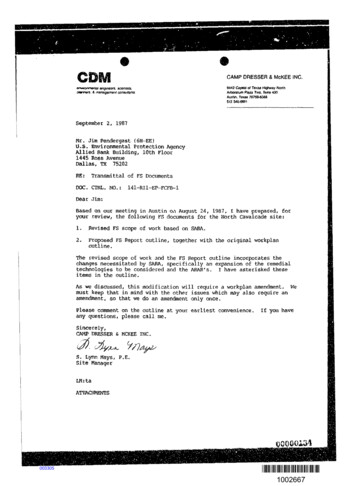
Transcription
CAMP DRESSER & McKEE INC.et**ronm&itai engineers, scientists,otanrvn 4 management owwyflaffls9442 Capua! of Texas Highway NorthArboretum Plaza Two. Suits 400Austin. Texas 7875 638851234&68P)September 2, 1987Mr. Jim Pendergast (6H-EE)U.S. Environmental Protection AgencyAllied Bank Building, 10th Floor1445 Ross AvenueDallas, TX 75202RE: Transmittal of FS DocumentsDOC. CTRL. NO.: 141-RIl-EP-FCFB-lDear Jim:Based on our meeting in Austin on August 24, 1987, I have prepared, foryour review, the following FS documents for the North Cavalcade site:1. Revised FS scope of work based on SARA.2. Proposed FS Report outline, together with the original workplanoutline.The revised scope of work and the FS Report outline incorporates thechanges necessitated by SARA, specifically an expansion of the remedialtechnologies to be considered and the ARAR's. I have asterisked theseitems in the outline.As we discussed, this modification will require a workplan amendment. Wemust keep that in mind with the other issues which may also require anamendment, so that we do an amendment only once.Please comment on the outline at your earliest convenience. If you haveany questions, please call me.Sincerely,CAMP DRESSER & MCKEE INC.7/1S. Lynn Mays, P.ESite ManagerLH:taATTACHMENTS003305*1002667*1002667
5.0 FEASIBILITY S'iUDY SCOPE OF WORKThe Superfund Amendment and Reauthorization Act (SARA) has separated theremedial investigation (RI) and feasibility study (PS) process into fivephases. The RI/FS phases as they relate to the feasibility study aredescribed in this section.The purpose of the Feasibility Study (FS) is to develop and evaluatelemedial action alternatives, to determine which remedial actions are bestsuited to potential and existing hazards at the site, and to prepare aconceptual design for a selected remedial alternative(s). Evaluations andanalyses conducted in the Feasibility Study will be consistent with theprocedures of the National Contingency Plan (NCP) and the SuperfundReauthorization Act (SARA) which favor the selection of a cost-effectivealternative that is technologically feasible and reliable and whicheffectively mitigates and minimizes damages to, and provides adequateprotection of public health, welfare, and the environment. SARAspecifically emphasizes alternatives that destroy or detoxify wastes asopposed to merely containing it.The effectiveness and feasibility of remedial action alternatives will beevaluated for the potential human and environmental pathways identified inthe RI. In order to assess the impact and effectiveness of remedialaseasures, it is necessary to understand the magnitude and extent ofcontamination existing at the site.5-1 FEASIBILITY STUDY PHASE I (FS PHASE I) DEVELOPMENT OF' P RELIMINARYALTERNATIVESThe FS Phase I includes the establishment of response criteria andobjectives, identification of alternative technologies, initial screeningof remedial alternatives, and recommendation of remedial alternatives forfurther analysis.5-1003306
5.1.1 SUBTASK 1,1 - DEVELOPMENT OFPRELIMINARY REMEDIAL TECHNOLOGIESThe objective of this task is to compile a list of alternative potentialsource control and on- and off-site remedial technologies based on theremedial investigation response criteria and objectives established by thepublic health assessment. TheFS Phase I will be an interactive processthat will he integrated with P.IPhase I so that data and criteria collectedduring f.he RI vill be available as necessary during the course of the PS.FS Phase I will involve development of remedial technologies in at leastone of the categories listed below. SARA emphasizes the consideration ofinnovative technologies and new, potentially viable technologies, will beconsidered. Additional categories may be developed during the course ofthe RI/FS.1. Contaminant destruction through incineration, natural or chemicaldegradation.2. Contaminant chemical fixation or demobilization.3. Contaminant detoxification through natural or chemical means.4. Contaminant removal from ground water through pumping.5. Leaching for subsequent capture and removal of contaminants fromsoil.6. Excavation and removal of contaminated soils.7. Capping, slurry wall, or other means of in-place containment.5.1.2 SUBTASK 1.2 - SCREENING OF PRELIMINARY TECHNOLOGICAL ALTERNATIVESThe remedial technologies identified during FS Task. 1.1 will be screenedfor applicability to site conditions and contaminants and for suitabilityfor inclusion in relevant remedial alternatives.5-2003307
5.1.3 SUBTASK 1.3 - DEVELOPMENT OF PRELIMINARY REMEDIAL ALTERNATIVESThe relevant technologies identified during FS Task 1.2 will be assembledinto viable remedial alternatives. To the extent possible and appropriate,at least one remedial alternative vill be developed in'each of thefollowing categories:o Nloaction.o An alternative that minimizes the need for long-term aanagement(including monitoring) at the site.o An alternative that reduces the principal threat posed by a sitethrough treatment, but would not necessarily involve treatment ofall waste or treatment to the maximum extent possible.o An alternative that involves containment of vaste vith little or notreatment, but provides protection of human health and theenvironment.o An alternative that utilizes alternative treatment or resourcerecovery technologies.Specific categories of remedial alternatives vhich will be developed wouldinclude the following list at a minimum:1. No action2. Institutional Controls3. Alternative Water Supply4. Ground Water Treatment5. Hydrodynamic Control ofVaste Migration6. In-Situ Treatment7. On-Site Treatmento Some monitoring, sample collection,and analyses may be included.o Fencing, warning signs, zoning,deed restriction.o Convert to municipal water system.o On-site water treatment facility,pumping wells.o Pumping wells, injection wells,slurry wall, water treatment, deepdrainage ditch.o Biodegradation, chemical fixation.o Incineration, chemical treatment ofpumped water, air stripping.5-3003308
8.9.10.11.o Paving, clay cap.Physical IsolationPartial Removalo Soil excavation.Total Removalo Soil excavation.Any combination of theabove alternatives.Deliverable — Technical Memorandum5.2 FEASIBILITY STUDY PHASE II (FS PHASE II) SCREEHING OFPRELIMINARYALTERNATIVESThe alternatives developed in the previous tasks vill be subjected toinitial screening in order to narrov the list of potential remedial actionsfor further detailed analysis. The criteria to be used in screening are:(1) effectiveness in contributing to the protection of public health,welfare, and the environment; (2) technical feasibility and reliability;and (3) cost of alternative implementation. The screening methodologiesare briefly described in the subtasks that follow.5 . 2 . 1 SUBTASK 2.1 - PUBLIC HEALTH AND ENVIRONMENTAL SCREENINGThe alternatives that may introduce significant adverse impacts or do notadequately protect public health and the environment vill be evaluated forelimination. The criteria to be used in this assessment will be theperformance criteria and standards developed during the RI (Section 3.2)and/or the results of the Risk Assessment. Those alternatives whichprovide similar environmental and public health and welfare benefits villbe identified. Because alternatives evaluated during the initial screeningvill not have been fully designed in an engineering sense, insufficientdetails will be available at this step to fully describe the potentialhealth and environmental effects of each alternative. Rather, thisscreening will establish objectives for cleanup and information needs forperforming the detailed screening of selected alternatives. Only those5-4003309
alternatives with a clear potential for causing adverse effects whencompared to other alternatives will be eliminated at this step.The Reaedial Investigation Public Health Evaluation constitutes thepreliminary Public Health and Environmental Analysis of the "no action"alternative. Using this analysis as a baseline, a comparative analysiswill be performed for alternative remedial measures identified duringalternatives developed. Such evaluations will enable an assessment to bemade of the extent to which remedial actions will reduce or eliminate thepotential for exposure to contaminants for each of the major exposurepathways. An important component of an assessment of remedial alternativesthat involve removal and off-site disposal of hazardous materials is theconsideration of exposures that may result during excavation andtransportation. Tie results of the PHE vill be used as a basis for publichealth and environmental (or effectiveness) screening.5.2.2 SUBTASK 2.2 - TECHNICAL FEASIBILITY SCREENINGEach alternative will be screened to eliminate those which cannot beimplemented using acceptable engineering practices, or are not compatiblevith conditions at the site (e.g., location in a populated area, proximityto surface water drainages). The screening technique will consist of thedevelopaent of cleanup scenarios, to determine those methods which bestaddress site problems. A matrix-type methodology may be employed, composedof the various alternatives and their engineering and technologicalcriteria. The alternatives must be feasible for the location andconditions of the release, applicable to the problem, and represent areliable means of addressing the problem.5.2.3 SUBTASK 2.3 - COST SCREENINGThe objective of the cost screening will be to eliminate those alternativeswhose costs are an order of magnitude greater than other alternatives, yetdo not provide substantially greater environmental or public health5-5003310
benefits, unless the more expensive alternative(s) are necessary to meetapplicable or relevant and appropriate requirements. The cost screeningwill include: (1) the estimation of costs, including both capital andoperation and maintenance costs; (2) present vorth analysis, consideringboth capital costs and other expenditures; and (3) a cost screeningcriteria evaluation vhich vill compare the present worth costs ofcompleting remedial actions having similar environmental, public health,and public welfare benefits. Alternatives foui.d to be more expensive(e.g., by an order of magnitude) ani offering similar or lesserenvironmental or public health benefits than competing alternatives vill beeliminated. Alternatives found to be more expensive but vhich offersubstantially greater environmental and/or health benefits will beconsidered. Costs vill be used to discriminate among treatmentalternatives, but not betveen treatment and non-treatment alternatives.5.3 TASK 3,0 - REMEDIAL INVESTIGATION PHASE II (RI PHASE II)The fourth phase of the RI/S process involves collection of additional dataand information on the treatability, detoxification, containment, removal,etc., of the contaminants so that remedial alternatives can be analyzed indetail. RI Phase II may involve additional field studies, bench testing,pilot plant performance checks, literature reviews, and similar activitiesas dictated by the requirements of remedial alternatives identified duringPS Phase II. Because the scope of the feasibility study Phase II cannot beidentified until remedial alternatives are defined, costs fov RI Phase IIhave not been included in this Work. Plan. The approximate time that thisactivity vould occur is included in the schedule, however.5.4 TASK 4.0 - DETAILED ANALYSIS OFALTERNATIVES (FS PHASE III)Once the initial alternatives have been screened using costing, acceptableengineering practices, and effectiveness criteria, the selected alternatives will be subjected to a more detailed evaluation. This evaluationvill be partially based on additional field studies, pilot or bench5-6003311
testing, or other information collected during RI Phase II.The detailedanalysis o* alternatives represent FS Phase III or RI/FS Phase V. Thedetailed analysis of each remaining alternative will include:o Refining and developing detailed specifications for eachalternative. Emphasis will be on proven technology. Innovative ortechnological measures will be treated as separate alternatives.o Detailed cost estimating, including operations and maintenance costsand cost distribution.o Evaluating alternatives in terms of engineering implementation,reliability, and constructability.o Assessing the extent to which the alternatives are expected toeffectively prevent, mitigate, or minimize threats to, and provideadequate protection of, public health, welfare, and environment.This will include an evaluation of the extent to which thealternative allows or exceeds applicable or relevant Federal publicoooohealth or environmental standards, advisories, and criteria. Wherethe analysis determines that Federal public health or environmentalstandards are not applicable or relevant, the analysis will evaluatethe risks of the various exposure levels projected or remainingafter implementation of the alternative under consideration.Analyzing whether recycling/reuse, waste minimization ordestruction, or other advanced, innovative, or alternativetechnologies are appropriate to reliably minimize present or futurethreats to public health, welfare, or the environment.Analyzing any adverse environmental impacts, methods for mitigatingthese impacts, and costs of mitigation.Analyzing relationship to appropriate or relevant and applicablerequirements.Analyzing whether the alternative significantly reduces volume,toxlcity, or mobility of contaminants.The PHE performed under the Remedial Investigation constitutes anassessment of the "no action" remedial alternative. Using this analysis asa baseline, a comparative analysis will be performed for alternativeremedial measures.003312
Once alternatives passing the initial screen have been sufficientlyengineered, so that appropriate data is available for evaluation, thepotential health and environmental effects associated vith each alternativevill be evaluated in detail.Although the purpose of remediation is to reduce risk, and the end resultaay in fact be a reduction in long-term risk, application of any specificremedial technology is frequently accompanied by the introduction ofincremental risks specifically associated vith the technology. Forexample, removal and off-site disposal of contaminated soils may create anadditional exposure pathway, and pumping and treatment of contaminatedground water «ay cause the vorkers to be exposed to volatilized organiccompounds. These and other appropriate factors will be weighed against theoverall reduction of risk affected by each technology as part of theassessment of alternatives.A comparative evaluation of each of the alternatives analyzed in detailwill be made. The evaluation will utilize the detailed informationcollected during the RI and vill result in a ranking of the alternatives ina manner to support a recommendation. Specific methodologies for thecomparative evaluation (including ranking) are still being developed at anationwide level. These methods will be expanded and/or further developedspecifically for the North Cavalcade site.5.5 TASK j.O -.FEASIBILITY STUDY REPORTAn FS report vill be completed to clearly document all aspects of thefeasibility study. The format of the report will be consistent with EPAguidance and will accomplish the following objectives:1. Ensure that public health and all major issues are adequatelyaddressed.2. Enhance comparability of feasibility studies for all sites.3. Ensure adequate documentation of the decision-making process.5-8003313
The four major steps in the compilation of the FS report are: (1) preparation of the Draft Feasibility Study report for release to the public forreviev; (2) a public hearing on the Draft FS Report to obtain comments; 3) revision to the Draft FS report incorporating all comments provided bythe EPA; and (4) preparation and distribution of the final FS report tosupport the Record of Decision.5-9003314
REVISED FS REPORT OUTLINE (08/87)TABLE OF CONTENTSSection1„0EXECUTIVE SUMMARYINTRODUCTION . . . . . . . . . . . . . . . . . . . . . . . . . . . . . . . . . . . . . . . . . . . . . .1.1 Purpose . . . . . . . . . . . . . . . I . . . . . . . . . . . . . . . . . . . . . . . . . . . . . .1.2 Background . . . . . . . . . . . . . . . . . . . . . . . . . . . . . . . . . . . . . . . . . . .1.2.1 Site Location and Description . . . . . . . . . . . . . . . . .1.2.2 Envi ronmental Setting . . . . . . . . . . . . . . . . . . . . . . . . .1.3 Nature and Extent of Problem . . . . . . . . . . . . . . . . . . . . . . . . .1.4 Objectives of Remedial Actions . . . . . . . . . . . . . . . . . . . . . . .1.4.1 General . . . . . . . . . . . . . . . . . . . . . . . . . . . . . . . . . . . . . . .1.4.2 Cleanup Objectives . . . . . . . . . . . . . . . . . . . . . . . . . . . . .1.5 Cleanup Goals . . . . . . . . . . . . . . . . . . . . . . . . . . . . . . . . . . . . . . .* 2.0REMEDIAL RESPONSE OPTIONS SELECTED FOR PRELIMINARYSCREENING . . . . . . . . . . . . . . . . . . . . . . . . . . . . . . . . . . . . . . . . . . . . . . . . .2.1 General . . . . . . . . . . . . . . . . . . . . . . . . . . . . . . . . . . . . . . . . . . . . . .2.2 Identification and Screening of Remedial Technologies,2.3 No Action Alternative . . . . . . . . . . . . . . . I . , . . , . . , . . . * . . . .* 2.4 Facilities for Treatment, Storage, or Disposal (TSD)of Contaminated Ground Water . . . . . . . . . . . . . . . . . . . . . . . . .2.4.1 Flocculation, Sedimentation, and Filtration .2.4.2 Activated Carbon Adsorption . . . . . . . . . . . . . . . . . .* 2.5 Facilitiesfor Treatment, Storage, and Disposal (TSD)of Contaminated Soils . . . . . . . . . . . . . . . . . . . . . . . . . . . . . . . .2.5.1 Off-site RCRA Approved TSDFacility . . . . . . . . . . .2.5.2 On site Extraction TSD Facility . . . . . . . . . . . . . . .2.5.3 On-site Stabilization/Solidification . . . . . . . . . .2.5.4 On-site Containment/Encapsulation . . . . . . . . . . . . .2.5.5 On-site Incineration . . . . . . . . . . . . . . . . . . . . . . . . .2.5.6 Off-site Incineration . . . . . . . . . . . . . . . . . . . . . . . .2.5.7 On-site Thermal Treatment . . . . . . . . . . . . . . . . . . . .2.5.8 Off-site Thermal Treatment . . . . . . . . . . . . . . . . . . . .2.5.9 Land Treatment . . . . . . . . . . . . . . . . . . . . . . . . . . . . . . .2.5.10 In-Situ Biological Degradation . . . . . . . . . . . . . . .2.6 Preliminary Screening Criteria . . . . . . . . . . . . . . . . . . . . . .* 2.7 Applicable or Relevant and Appropriate requirements(ARARs) . . . . . . . . . . . . . . . . . . . . . . . . . . . . . . . . . . . . . . . . . . . . .2.7.1 Federal AHARs . . . . . . . . . . . . . . . . . . . . . . . . . . . . . . . .2.7.1 State ARARs . . . . . . . . . . . . . . . . . . . . . . . . . . . . . . . . . .2.8 Technologies Recommended for Detailed Evaluation . . . . .2.8.1 Technical Feasibility Evaluation . . . . . . . . . . . . .2.8.2 Public Health and Environmental Protection . . . .2.8.3 Cost . . . . . . . . . . . . . . . . . . . . . . . . . . . . . . . . . . . . . . . . .2.9 Technologies Recommended for Detailed Evaluation . . . . .ii003315
TABLE OF CONTENTSSection3.0DESCRIPTION OF REMEDIAL ACTION ALTERNATIVES . . . . . . . . . . . .3.1 General . . . . . . . . . . . . . . . . . . . . . . . . . . . . . . . . . . . . . . . . . . . .3.2 No Action Alternative . . . . . . . . . . . . . . . . . . . . . . . . . . . . . .3.3 soil Excavation . . . . . . . . . . . . . . . . . . . . . . . . . . . . . . . . . . . .3.3.1 Dewatering for Excavation . . . . . . . . . . . . . . . . . . .3.3.2 Well Points . . . . . . . . . . . . . . . . . . . . . . . . . . . . . . . . .3.3.45 GroundWater Treatment . . . . . . . . . . . . . . . . . . . . . . . . . . . . .Alternative 1 . . . . . . . . . . . . . . . . . . . . . . . . . . . . . . . . . . . . . .3.6 Alternative 2 . . . . . . . . . . . . . . . . . . . . . . . . . . . . . . . . . . . . . .3. 7 Alternative 3 . . . . . . . . . . . . . . . . . . . . . . . . . . . . . . . . . . . . . .4.05.0RESULTS OF LABORATORY/PILOT TESTS . . . . . . . . . . . . . . . . . . . . . . .ANALYSIS OF REMEDIAL ACTION ALTERNATIVES . . . . . . . . . . . . . . . .5.1 General . . . . . . . . . . . . . . . . . . . 4 . . . . . . . . . . . . . . . . . . . . . . . .5.2 Rating of Alternatives Based on Costs . . . . . . . . . . . . .5.2.1 Cost Methodology . . . . . . . . . . . . . . . . . . . . . . . . . . . .5.2.2 Capital Costs . . . . . . . . . . . . . . . . . . . . . . . . . . . . . .5.2.3 Annual Costs . . . . . . . . . . . . . . . . . . . . . . . . . . . . . . .5.35.45.55.2.4 Present Worth Analysis . . . . . . . . . . . . . . . . . . . . .Sensitivity Analysis . . . . . . . . . . . . . . . . . . . . . . . . . . . . . .Rating of Alternatives Non Cost Factors . . . . . . . . . . .5.4.1 Technical Feasibility . . . . . . . . . . . . . . . . . . . . . . .Institutional Requirements . . . . . . . . . . . . . . . . . . . . . . . .5.6 Public Health and Environmental Considerations . . . . .5.6.1 Treatment, Storage, and/or Disposal ofContaminated Soils . . . . . . . . . . . . . . . . . . . . . . . . . .5.6.2 Ability to Reduce Toxicity, Mobility, and/orVolume . . . . . . . . . . . . . . . . . . . . . . . . . . . . . . . . . . . . .6.07,0SUMMARY OF REMEDIAL ACTION ALTERNATIVES . . . . . . . . . . . . . . . . .IDENTIFICATION OF PREFERRED ALTERNATIVES . . . . . . . . . . . . . . . .REFERENCESAPPENDIX A CONCLUSIONS OF PUBLIC HEALTH EVALUATIONAPPENDIX B SUPPORTING DOCUMENTATION FOR COST ANALYSISAPPEM IX C DETERMINATION OF TARGET CONCENTRATIONS (BASED ON PUBLIC HEALTHCONSIDERATIONS) OF PAHs IN SOILS AND BTXs IN GROUND WATER ATTHE NORTH CAVALCADE SITEiii003316
CzvnltodeThe recomended alternative description will be prepared to meet the overallFeasibility Study requirements. However, a recommended alternative may ormay not be presented at the discretion o EPA. Guidance on whether or notto provide a recommended plan will be given by EPA prior to completion ofthe Feasibility Study.5.5 TASK 5.0 FEASIBILITY STUDY REPORT5.5.1 SUBTASK 5.1 - DRAFT FEASIBILITY STUDYObjective — To present the results of the Feasibility Study.Methodology — A draft Feasibility Study Report shall be prepared summarizing the results of Tasks 1.0 through 4.0. The report shall include thefollowing major sections:0.0 Executive Summary1.0 Introduction1.1 Site background1.2 Nature and Extent of Problem1.3 Objectives of Remedial Action2.0 Screening of Remedial Action Technologies2.1 Technical Criteria2.2 Environmental and Public Health Criteria2.3 Institutional Criteria2.4 Other Screening Criteria2.5 Cost Criteria2.6 Remedial Action Alternatives Development3.0 Remedial Action Alternatives3.1 Alternative 1 (No Action)3.2 Alternative 23.n Alternative N4.0 Results of Laboratory/Pilot Tests5.0 Analysis of Remedial Alternatives5.1 Non-Cost Criteria5.1.1 Technical Feasibility5.1.2 Environmental Feasibility5.1.3 Institutional Requirements5.1.4 Endangerment Assessment5.2 Cost Analysis6.0 Summary of Remedial Alternatives7.0 Recommended Remedial AlternativeReferencesAppendicesDeliverables Ten bound copies of the draft Feasibility Study Report,5-17003317
5.0 FEASIBILITY S'iUDY SCOPE OF WORK The Superfund Amendment and Reauthorization Act (SARA) has separated the remedial investigation (RI) and feasibility study (PS) process into five phases. The RI/FS phases as they relate to the feasibility study are described in this section. The purpose of the Feasibility Study (FS) is to develop and evaluate
